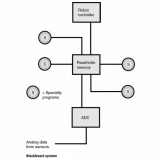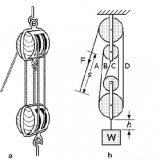Robotic Mechanisms – CAM MECHANISMS 51050
What is a Cam ? – What are CAM MECHANISMS ?
A cam is a mechanical component capable of transmitting motion to a follower by direct contact. In a cam mechanism, the cam is the driver and the driven member is called the follower. The follower can remain Stationary, translate, oscillate, or rotate.
A widely used open radial-cam mechanism is shown in Fig Below. The roller follower is the most common follower used in these mechanisms because it can transfer power efficiently between the cam and follower by reducing friction and minimizing wear between them. The arrangement shown here is called a gravity constraint cam; it is simple and effective and can be used with rotating disk or end cams if the weight of the follower system is enough to keep it in constant contact with the cam profile. However, in most practical cam mechanisms, the cam and follower are constrained at all operating speeds by preloaded compression springs.
Cams can be designed by three methods:
• Shaping the cam body to some known curve, such as a spiral, parabola, or circular arc
• Designing the cam mathematically to determine follower motion and then plotting the tabulated data to form the cam
• Drawing the cam profile freehand using various drafting curves
The third method is acceptable only if the cam motion is intended for low speeds that will permit the use of a smooth, “bumpless” curve.
In situations where higher loads, mass, speed, or elasticity of the members are encountered, a detailed study must be made of both the dynamic aspects of the cam curve and the accuracy of cam fabrication. Many different kinds of machines include cams, particularly those that operate automatically such as printing presses, textile looms, gear-cutters, and screw machines. Cams open and close the valves in internal combustion engines, index cutting tools on machine tools, and operate switches and relays in electrical control equipment. Cams can be made in an infinite variety of shapes from metal or hard plastic. Some of the most important cams will be considered here. The possible applications of mechanical cams are still unlimited despite the introduction of electronic cams that mimic mechanical cam functions with appropriate computer software.
Classification of Cam Mechanisms
Cam mechanisms can be classified by their input/output motions, the configuration and arrangement of the follower, and the shape of the cam. Cams can also be classified by the kinds of motions made by the follower and the characteristics of the cam profile.
The possible kinds of input/output motions of cam mechanisms with the most common disk cams are shown in Fig a to e; they are examples of rotating disk cams with translating followers. By contrast, Fig. f shows a follower arm with a roller that swings or oscillates in a circular arc with respect to the follower hinge as the cam rotates. The follower configurations in Figs. a to d are named according to their characteristics:
-a knife-edge;
-b, e,and f roller;
-c flat-faced;
-and d spherical-faced.
The face of the flat follower can also be oblique with respect to the cam. The follower is an element that moves either up and down or side to side as it follows the contour of the cam.
There are two basic types of follower: in-line and offset. The centerline of the in-line follower passes through the centerline of the camshaft. Figures a to d (Above) show five followers that move in a plane perpendicular to the axis of rotation of the camshaft.
By contrast, the centerline of the offset follower, as illustrated in Fig. e (Above), does not pass through the centerline of the camshaft. The amount of offset is the horizontal distance between the two centerlines. Follower offset reduces the side thrust introduced by the roller follower.
Figure f (Above) illustrates a translating or swingarm rotating follower that must be constrained to maintain contact with the cam profile. The most common rotating disk or plate cams can be made in a variety of shapes including offset round, egg-shaped, oval, and cardioid or heart-shaped.
Grooved Cam
Most cams are mounted on a rotating shaft. The cam and follower must be constrained at all operating speeds to keep them in close contact throughout its cycle if a cam mechanism is to function correctly. Followers are typically springloaded to maintain constant contact with the shaped surface of the cam, but gravity constraint is still an option.
If it is anticipated that a cam mechanism will be subjected to severe shock and vibration, a grooved disk cam, as shown in Fig Groove A, can be used. The cam contour is milled into the face of a disk so that the roller of the cam follower will be confined and continuously constrained within the side walls of the groove throughout the cam cycle. The groove confines the follower roller during the entire cam rotation. Alternatively, the groove can be milled on the outer circumference of a cylinder or barrel to form a cylindrical or barrel cam, as shown in Fig. Groove B. The follower of this cam can translate or oscillate. A similar groove can also be milled around the conical exterior surface of a grooved conical cam.
Design Ideas With Cam Mechanisms
Related Terms:
base circle: The circle with the shortest radius from the cam center to any part of the cam profile.
cam profile: The outer surface of a disk cam as it was machined.
follower travel: For a roller follower of a disk cam it is the vertical distance of follower travel measured at the center point of the roller as it travels from the base circle to the cam profile.
motion events: When a cam rotates through one cycle, the follower goes through rises, dwells, and returns. A rise is the motion of the follower away from the cam center; a dwell occurs when the follower is resting; and a return is the motion of the follower toward the cam center.
pitch curve: For a roller follower of a disk cam it is the path generated by the center point of the roller as the follower is rotated around a stationary plate cam.
pressure angle: For a roller follower of a disk cam it is the angle at any point between the normal to the pitch curve and the instantaneous direction of follower motion. This angle is important in cam design because it indicates the steepness of the cam profile.
prime circle (reference circle): For a roller follower of a disk cam it is the circle with the shortest radius from the cam center to the pitch curve.
stroke or throw: The longest distance or widest angle through which the follower moves or rotates.
working curve: The working surface of a cam that contacts the follower. For a roller follower of a plate cam it is the path traced by the center of the roller around the cam profile.






